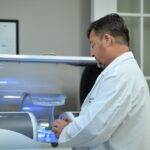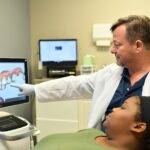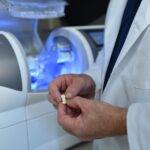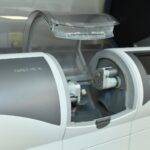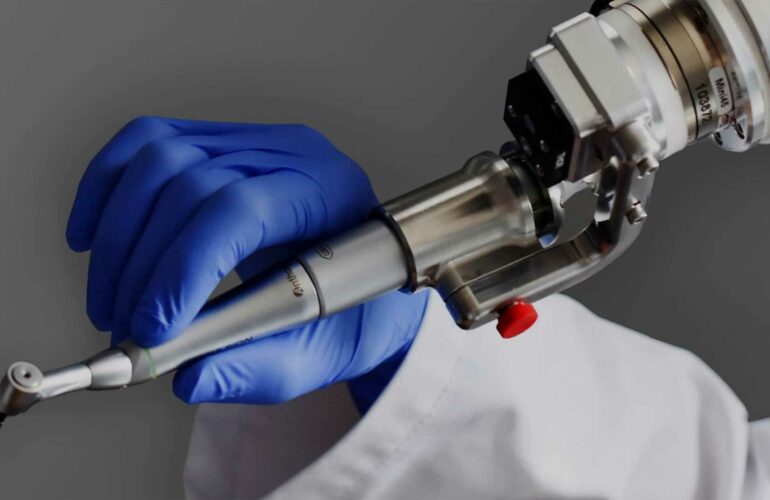What Are Dental Implants?
Dental implants aren’t often at the forefront of the conversation when discussing a dentist trip or considering procedures. They can seem like a daunting or extreme solution to oral health concerns, but really, implants can be a quick and streamlined process, leading to a beautiful, robust, and permanent smile. Implants may supplement natural, healthy teeth or completely replace weak ones. Today’s options are highly advanced, customizable, and indistinguishable from natural teeth.
Who Should Get Dental Implants?
It is easy to assume that, just like dentures, implants are only for those that are elderly or already wear dentures. This is an understandable but inaccurate assumption! While there are some limitations on who is a viable candidate, implants are an option for many of our patients with weak or unhealthy teeth.
Implants can be a breath of fresh air for those using dentures. Dentures can cause irritation and discomfort, requiring gums and glues to stay in place. This may result in an uncomfortable or awkward oral hygiene routine or be frustrating to maintain. A perk of implants is that it opens the door to both denture use and a new set of teeth, depending on preference. Implants can be used to attach dentures via strong magnets, thus making the process easier and nearly eliminating attachment issues throughout the day.
In addition to simplifying the monotonous routine of dentures, implants are used in places where bridges may typically be placed. We can replace a single tooth or several teeth or completely replace an entire smile with a complete set.
Just as we mentioned earlier, candidacy isn’t limited to those that are elderly or use dentures. Candidates can be as young as 16 for girls and 18 for boys. Anyone can have a chance if the facial bones are fully developed.
Those with facial deformities, heavy smokers, severe jaw damage, or bone erosion may need further consultation and could require a more in-depth procedure. In the case of bone erosion or a weak jaw, a bone graft or a more customized implant will be needed. This will allow the implant to take hold and eventually fuse to become one with your natural bone. Bone Support is crucial for the implants, so it is important to prioritize a healthy jaw before proceeding with the procedure.
In extremely rare cases, the jaw bone’s mass is not salvageable; therefore, the implant would then be inserted into the cheekbone. Regardless of current jaw health, there are many solutions and steps to ensure that those who want implants can get them.
What if I’m not immediately a candidate for dental implants?
If someone may not immediately be a candidate, several different procedures may be offered or suggested before pursuing dental implants. Bone augmentation is an option to provide sufficient bone mass for the implants to take hold. a sinus lift may also be an option and involves adding bone back due to missing top teeth. Lastly, those with a narrow jaw may require a ridge expansion which involves widening the upper jaw with a bone graft to create optimal space.
Instead of fixing other dental problems first, pursuing implants can be a more streamlined and better way to achieve your goals. Crowns are a way to get a solid and healthy set of teeth, so attempting to fix other problems first isn’t necessarily required. A consultation with an orthodontist can help clear up any questions or concerns about what may be necessary.
Questions, questions…
With so little information readily available about dental implants, it’s no wonder that so many people haven’t considered the option and have questions surrounding the mysterious topic. It’s only natural to wonder about the unknown.
Some may wonder: Do they hurt? Can they fall out? How long will they last? How do they feel? Do they look like natural teeth? What if I don’t like them? – all of these are valid and important questions to be answered. Hopefully, by the end of this article, we can demystify this dentistry category.
By the end of the process, you should not experience any pain or discomfort. However, there is a short healing process, which can be aided by over-the-counter pain medication. Depending on the number of implants, the healing process can be as quick as 1 to 2 days or 1 to 2 weeks. It is important to remember that each patient is different and will require additional time depending on oral health, age, and the number of teeth being replaced. Some may require several months to complete the healing process in special cases.
Proper oral hygiene and anti-inflammatory medication will help ease the healing process and help eliminate symptoms like swelling and discomfort. During the healing process, the implants begin to fuse with the jawbone to become a permanent fixture. This ensures that the new set of teeth can’t fall out. Once this healing process is complete, then the crowns will be added.
It is difficult to say precisely what the most crucial part of dental implants is, however, crowns or what is visible. Crowns are the new teeth. Simply put, crowns are like caps that go over the implants. The highest quality of material for crowns Isn’t commonly available, but that is the standard in our office. The crowns will be made of zirconia and designed to look and feel completely natural and indistinguishable from a real tooth.
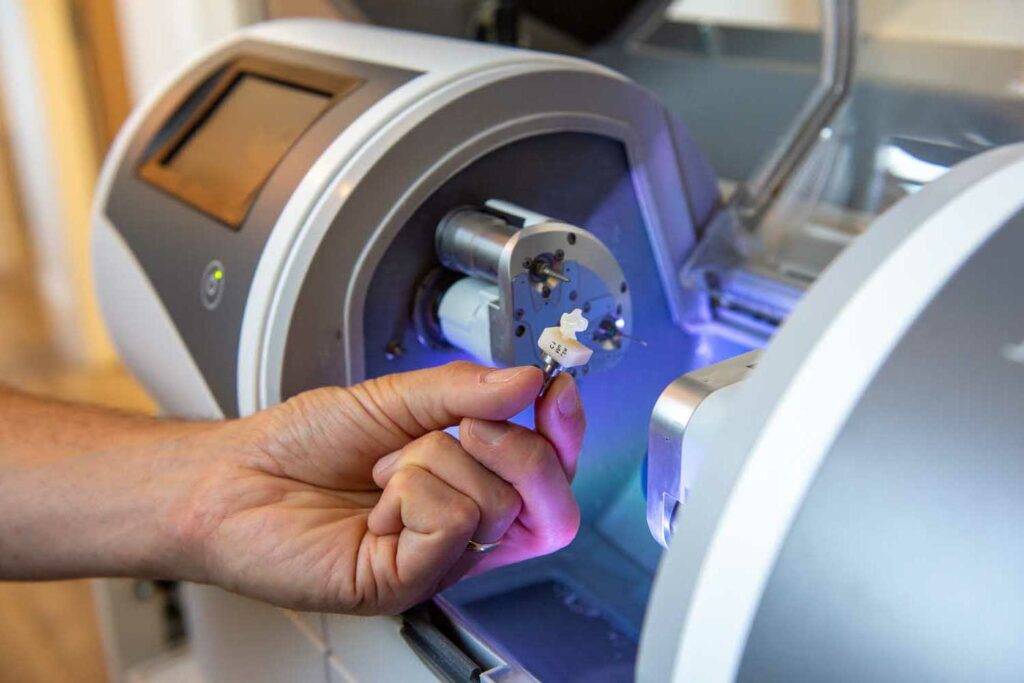
Implants should not feel any different from a normal tooth and can last longer due to the incredibly strong makeup of zirconia. The lifetime of implants is around 25 years and can easily be updated or repaired when needed. Considering the lifetime and fragility of a natural tooth, it can be argued that these artificial teeth may be better than real ones.
Since crowns can be replaced easily, it is simple to update or change the look of teeth at any time. This allows for complete and total customization.
Are there different types of dental implants?
There are two main types of dental implants, Endosteal and Subperiosteal. Endosteal implants are the most commonly used type. This is likely the type people envision when hearing the word “implant.” The screw-like cylinder will be placed into the jaw and fuse with the surrounding bone to form an artificial root.
Subperiosteal implants will likely be offered to those with insufficient bone mass that do not wish to opt for a bone graft. Both types are relatively similar and will ultimately end with crowns that look the same.
Both options allow for fixed implants or removable ones. If the patient prefers dentures, magnets can replace the crowns in the future. Conveniently, these magnets make attaching dentures much faster, with less mess and increased stability.
What are dental implants made of?
Biocompatibility is incredibly important when integrating a foreign object into the body. Due to this, all implants are made from a titanium alloy. To compare, this is the same material used in hip, shoulder, and other joint replacements. Unlike other metals, titanium is highly unlikely to cause reactions.
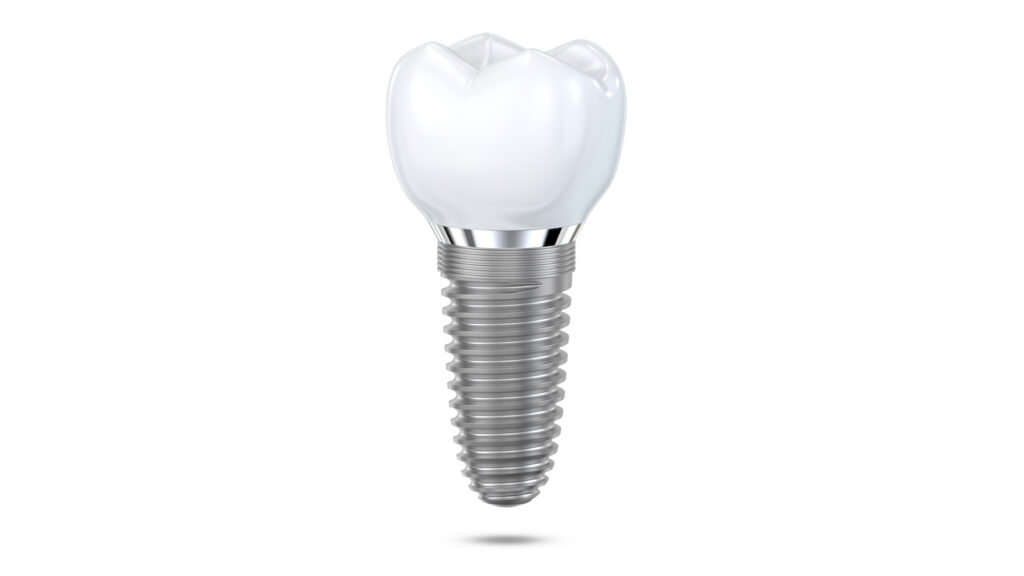
Titanium allergies are extremely rare. Only about 0.6% of people in the world have a titanium allergy. In these extraordinary cases, it is possible to use the same crown material, zirconia, to produce the implant. A MELISA test can be taken before the procedure to rule out allergies.
Titanium is also preferred to other metals due to its compatibility with bone, allowing it to properly osseointegrate (fuse with the bone).
The Chair-Side Experience
Dental implants have come a long way compared to the contraptions used in 2000 BC. The technology available today is nothing like in the past and allows the process to be completed incredibly quickly. CEREC machines have made it possible for a complete chair-side experience.
CEREC machines are a specialized type of milling system used to create crowns. They are highly advanced and use 3D software to create a perfect tooth, customized for each individual. This 3D software allows the crown to be made in-house instead of sending out an order. This means no more uncomfortable tooth molds!
We will take high-resolution photos and x-rays, then we’ll use one of our CEREC crown milling systems which takes the information and media to produce a 3D model of our patient’s mouth. This can then be displayed to our patient on a computer screen. Interacting with the 3D model in real-time helps bring the entire experience to life.
Once the 3D model is produced, it can be shown to you and interacted with. This allows you to choose how your new teeth will look.
Custom Tailored for You
Seeing the difference between your smile’s current and future version can help ease worries and instill confidence. Our implant specialist dentists can show you the 3D model of your smile from every angle and pinpoint specific areas where changes will be made. During this process, you can provide input and collaborate, all from the dental chair.
After creating the model and choosing how your new teeth will look, we will offer you color choices. In the case of single or multiple implants, we will likely suggest color matching the new crowns to your natural teeth. At this point, you may want to consider teeth whitening options, as the material crowns are made of cannot be whitened.
Whitening is optional and does not affect the overall outcome of your new smile. However, if in the future you want to pursue teeth whitening and your implant is in a visible place, you would need a new crown to match the whiter shade.
Our Zoom Whitening treatment can lift up to 8 shades in just 45 minutes. If you opt for treatment beforehand, it can likely be completed the same day.
Crowns: Creating New Teeth
Once the color shade is selected for the new crown, Our laboratory technicians will choose a cube of zirconia and insert it into the CEREC machine. The machine then carves the ceramic with flawless precision in under 20 minutes.
One benefit to using a machine like this, instead of having someone hand-carve the tooth, is that it eliminates human error. Additionally, the speed of this machine allows for same-day crowns and a much shorter appointment time.
Amelia Perfect Smile employs CERAC state-of-the-art dental milling systems for all custom crowns.
The material used in creating these crowns is tough… VERY tough. Carving zirconia ceramic requires a special addition to the mill, making this option somewhat exclusive. Amelia Perfect Smile uses zirconia for virtually ALL of our crowns because it’s the highest quality, longest lasting, and most durable material. This unique material, in combination with the CEREC machine, means reduced waste and remarkably realistic crowns. The goal is to blend natural and artificial teeth perfectly.
Additionally, with a titanium alloy base, and a zirconia crown, there are no roots to get infected! In several ways, dental implants are even better than natural teeth.
What’s the Timeline?
Your experience will vary from other cases, but let’s walk through what a typical timeline might look like.
To begin, you will need to schedule an appointment with us for a consultation and express your needs to our implant specialist dentist. Our dentist will assess your current oral hygiene and the state of your teeth and suggest a treatment plan. Same-day crowns are available; however, another appointment with properly allotted time will be necessary in some cases.
Once you have established a means of treatment, we will prepare you for your implants. The procedure will take place on a separate day, and the healing begins. This can last from as little as one day to a couple of weeks, or in more in-depth cases, a couple of months. After this healing stage, the crowns can be applied.
Your final appointment will likely only last a couple hours while the crowns are fitted. At this point, you can choose the color of your new teeth and opt for a whitening treatment. If we haven’t created your crowns ahead of your appointment, for instance If we’re replacing just one tooth, we will select a cube of zirconia ceramic and input it into the CEREC machine. 10-20 minutes later, your perfectly sculpted crown will be finished. Next, the new teeth will be custom color matched before the fitting process.
Once your new crowns are attached, you are finished! After everything is done, we will give you an after-care plan which includes proper oral hygiene suggestions and foods to avoid. These food aversions are only temporary while your new implants take root and finish fusing. After completing this process, you are free to eat anything you like and treat your implants mostly like natural teeth.
Maintenance & Aftercare
The extended aftercare and overall maintenance of your implants will be very similar to taking care of natural teeth. However, we suggest some specific things to maintain the best condition of your teeth.
You should avoid abrasive toothpaste and opt for a nylon or soft-bristle brush. Implant-specific floss is available, or you may use a regular non-wax version. You may also consider an oral irrigator or Waterpik to help reach difficult places when brushing. Just as with natural teeth, hard foods should be eaten carefully. Smoking and alcohol are, as always, not recommended.
Summing it all up
There are many things to consider regarding dental implants, so making the decision can feel overwhelming. We hope this article helps you remove some of the mystery and uncertainty surrounding dental implants. It is a big decision and is best made in collaboration with your dentist.
If you feel dental implants are a good fit for you or want more information, don’t hesitate to call us to schedule a consultation. The process begins when you want it to.
Regardless of your insurance or income, we have excellent financing options and really can help you attain your perfect smile.








